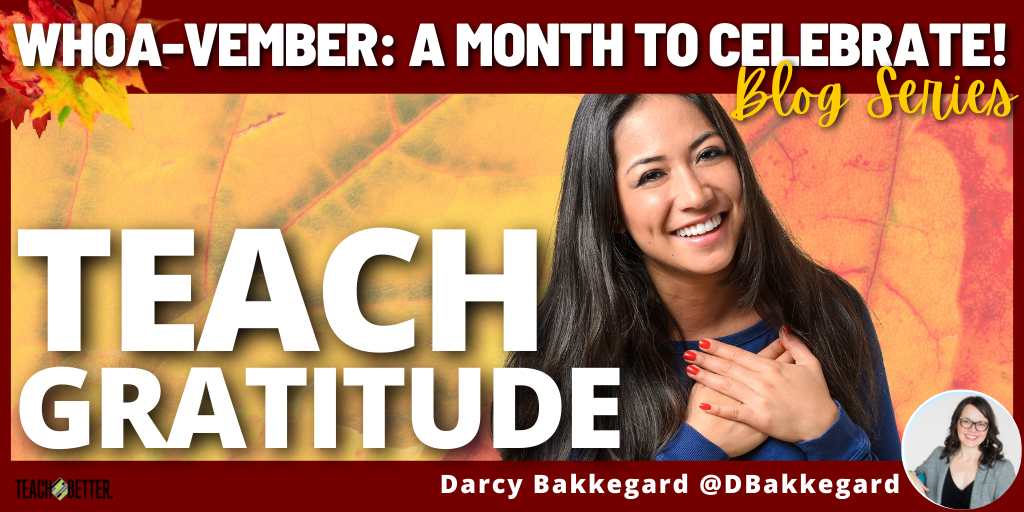TL;DR:
- Teaching gratitude has benefits for students, teachers, and the community.
- There are many simple activities for all ages that you can embed into your classroom.
- Incorporate gratitude into your own life.
There’s a lot of talk about the need for teacher self-care but less about simple hows and whens. But what if self-care wasn’t something separate? What if we could infuse self-care right into our teaching practice? Try teaching gratitude.
Teaching Gratitude
Dr. Sirven, chair of Neurology at Mayo Clinic’s Arizona campus, explains that “Research on gratefulness has shown numerous psychological and physical benefits for both the recipient and provider, including improved pain tolerance, better sleep, lower blood pressure, less depression, and increased longevity” and can help us “cope with chronic illness and everyday stress” (Give the Gift of Gratitude).
As you embed and model gratitude in lessons, you’ll not only help the recipients—your students—reduce stress and increase joy, you—the gratitude provider—will benefit as well. Students then become gratitude providers as they share their gratitude with others, sending a rippling gratitude wave through your community.
And since time is scarce and resources few, here are some of my favorite easy-to-implement gratitude activities, adaptable to any age.
Students become gratitude providers as they share their gratitude with others, sending a rippling gratitude wave through your community. Click To TweetTeaching Gratitude Activities
Deploy the Super Secret Gratitude Force. Enlist students as Gratitude (or Compliment) Secret Agents. Their mission: write notes of gratitude and/or compliments for people in your school/community. Then, arm them with post-its and have students leave specific notes for specific people without being seen. Make gratitude magic!
Make a class gratitude pumpkin! Everyone adds their name & 1 item of gratitude. After that, display it in your classroom.
Start a class gratitude jar. Decorate it and keep cubes of paper near. Encourage students to add notes of gratitude. Then, use the jar for writing prompts for Monday pick-me-ups. Start a school gratitude jar and read the notes during announcements. Speaking of announcements…
Take over the daily announcements. In addition to a reminder of what’s for lunch, share a daily item of gratitude, a quote, or a gratitude challenge.
Create Gratitude Snaps. Then, designate a Gratitude Wall, and post pictures, prompts, & creations throughout the year. Let the wall grow & expand throughout the holiday season.
Make a Gratitude Collage. Give each student a large piece of paper. From time to time, have students add a note or an image, and watch their gratitude collage grow. Or make a growing digital collage with AdobeSpark, Sway, Canva, or Google Slides. Grow gratitude year-round!
Make a Gratitude Top Ten list. Use words or pictures, but rank your top 10. Connect to the curriculum and have students make lists for historical figures, book characters, or math facts.
Take a Tangent. Studying atoms? Then make gratitude atoms (What’s in your nucleus? What are your electrons?). Learning about math facts? Then write gratitude facts. Whatever you’re teaching, take a tangent and embed a little gratitude, however cheesy it might feel.
Speaking/Writing
Start a daily gratitude journal. Each day, list 3-5 items for which you are grateful. Then, draw or snap a pic; write a poem, paragraph, or list explaining the what & why. Share or post student responses as you like.
Use Flipgrid to have students post a weekly video gratitude note. Then, share the post with parents & other classes so everyone can post & share their gratitude.
[scroll down to keep reading]
Join StoryCorps for the Thanksgiving challenge. Have students interview a family member using the free StoryCorps app, and add a question to each interview about gratitude. OR use Flipgrid or StoryCorps to help students interview a person for whom they are grateful, but don’t tell the people being interviewed why they are being interviewed! During the interview, surprise the interviewees with a declaration of gratitude.
Host a Gratitude Slam. Share this video of a girl slamming about all the things she’s grateful for. Then, have students do the same. Slam out loud or in writing; slam with Seesaw or Flipgrid. Have them slam in the classroom or ask the admin to slam announcements.
Go back to the basics and write thank-you notes. Send them to those in and outside of school. In addition, you can add a lesson on how to address mail. 🙂
Write a letter. A note is nice, but some things need a letter. Students could even use Flipgrid or Seesaw to record and post their letters of gratitude.
Your Turn
See the Good. Remind yourself of all the good around you. Think of ways you can share your gratitude. Use this graphic organizer to get started.
Tell each student why you are grateful for them. With a post-it note, in a Seesaw post (also shared with guardians), in a conversation, or with a picture…tell them. Yes, this is more time-consuming for middle and high school teachers, but well worth it.
Write your own letter(s). Let those around you know how much they mean to you. Not sure where to start? Then, look back at your gratitude graphic organizer.
Click here for a full list of my favorite gratitude activities.
See the full “Whoa-vember: A Month to Celebrate” blog series here!
About Darcy Bakkegard
Darcy Bakkegard is an English/Theatre teacher who got tired of traditional sit-n-get PD and now creates the type of PD she always wanted with The Educators’ Lab. With 10 years of experience teaching English and Theatre, Darcy specializes in interactive strategies for the classroom, meaningful tech integration, and building relationships with students. Darcy is an ISTE Certified Educator, an experienced international presenter, and empowerer of teachers. She co-authored The Startup Teacher Playbook to help teachers take back their professional development and rekindle their spark for teaching.



